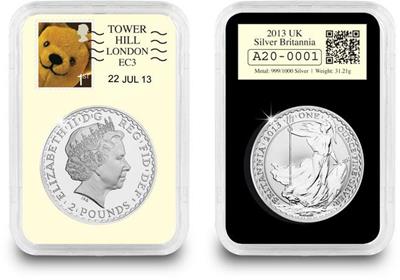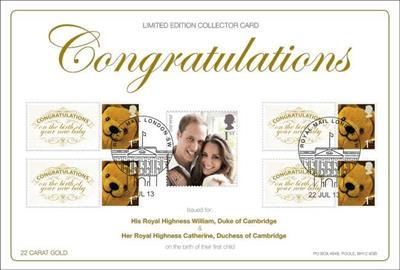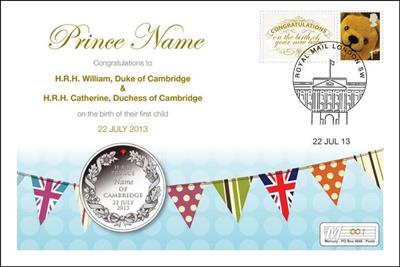Royalty
The low-key Christening that’s of high interest to collectors.
Prince George Louis Alexander of Cambridge is set to make his second public appearance in his early life, amid a frenzy of public interest both here and around the world.
However, when the young Prince is baptised at the Chapel Royal in St James, there could be fewer than 60 people in attendance. All the public will see and hear of the 45-minute ceremony is the official photos and a few details which William and Kate choose to release the following day. So far the only photographs are family snapshots taken by Kate’s father Michael Middleton.
William and Kate’s wedding along with Prince George’s birth on 22nd July has been credited with bolstering the popularity of Britain’s Royal family both home and abroad.
Millions of people around the world watched live coverage of the Duke and Duchess leaving the hospital with their sleeping son – the only public sighting of George to date.
Australia and Canada among other Commonwealth countries have issued their own tributes to Prince George as the popularity of the Royal family continues to grow internationally.
In fact, Australia was the first major country to feature an image of young baby George on a commemorative coin – with a design portraying him with his proud mother and father.
Despite being held behind locked gates, royal fans are still expected to descend on St James’ Palace to soak up the atmosphere and wait patiently for a glimpse of the young Prince.
By removing the grandeur of the occasion, there is secrecy and intrigue surrounding the ceremony which has led to a surge in demand from collectors looking for a keepsake from what remains a hugely significant Royal event.

The DateStamp Royal Christening Sovereign is a collector’s favourite
In terms of commemorative coins, limited edition issues like the DateStamp™ Royal Christening Sovereign have been snapped up. Collectors not only look for the history and heritage of a Sovereign which you would expect for a future King, but also recognise the unique appeal of an Official Royal Mail postmark on the day of the Christening which captures the moment forever. With an edition limit of only 495, there has been a last-minute scramble to try and secure one.
Traditionally, it is seen as good fortune to cross a newborn’s palm with a silver coin, which also explains the incredible popularity of the Prince George Silver Proof £5 – struck from Sterling Silver and limited to just 2,013 pieces.
It’s certainly not a day that young George will remember, but for millions of others around the world, the christening of the future King of England is a day to be commemorated.
Kate Gives Birth to a Collecting Frenzy
Managing Director, Ian Glen, helps you pick through the Royal Baby commemorative jungle.
It’s 9.57 am. Less than 24 hours after the Duke and Duchess of Cambridge have been blessed with a new baby boy and a nation with its future King.
The Prince has not even been given a name yet but already there is a vast array of commemorative memorabilia.
One of our most important jobs is to select for you the very best commemorative issues that will mark the birth our future King in the most appropriate way and create a lasting heirloom that you can pass down to your children and grandchildren.
But which of the hundreds of commemorative pieces will stand the test of time?
Well let me share with you some of the elements that I believe are most important when we select the pieces we recommend to collectors.
1. Capture a moment in time

The Official Royal Mail Postmark captures the moment in time forever as with this DateStamp (TM) coin.
When there is a momentous occasion like a Royal Birth, I’m always keen to tie commemorative items back to that moment forever, which is why in my mind stamps create such a perfect collectable.
For example, we arranged well in advance for Royal Mail to hold a number of covers and other philatelic items ready for them to postmark with the all-important birth-date, as soon as it was announced.
These are true never-to-be repeated commemoratives, unlike so many items that will be manufactured for months after the birth.
2. History and heritage
.jpg)
The Gold-plated Commemorative features a timeless heraldic design and draws on hundreds of years of minting heritage.
By specialising in coins and stamps, we have already declared our hand that the best collectable items have a strong history and heritage. Coins, commemorative medals and stamps, of course, have long traditions as Royal Commemoratives and so make the perfect keepsake.
With much issuing information not yet in the public domain, you can also realistically expect British Isles issues, as well as coins and stamps from many key commonwealth countries to be announced over the coming days and weeks.
As always, the closer the links to the UK, typically the stronger the longterm heritage of the piece. And with a Christening some way off, I’m certain we have many important issues still to come.
3. Designed to stand the test of time
A commemorative piece should always be designed to create an enduring memory – something that you can pass down through the generations.
It is no coincidence that many of the most popular coins to be issued over the years feature heraldic representations. Rushed and imagined sketchy pictures of the Royal Couple and baby, bear little creative strength and over time risk looking tired and clichéd.
It’s also worth searching out something a little bit unusual – even unique – in the design, which is why I was delighted when we were able to select a silver commemorative design that actually contains the new Prince’s birthstone – a ruby – as an integral part of the design.
4. Edition limits that mean something

Just 2,000 22 Carat Gold Collector Cards have been issued. With an edition of just 2,000, they are tipped to be among the earliest sell outs.
Of course, many Royal Baby commemoratives will be issued in limited editions – but that is only of real importance if demand is actually going to exceed supply, resulting in collectors missing out.
Of course, there is no hard and fast rule but I like to ensure that we work hard to select commemoratives with edition limits that should see sell-outs, helping to ensure their long-term collectability.
Finally, there is just one other thing to add. Enjoy your collecting.
By owning a Royal Commemorative, you are ensuring that not only you, but also your children and grandchildren, will forever have an element of connection to the moment when a nation celebrated the birth of its future King.
 click here to view our full Royal Baby Commemorative Range
click here to view our full Royal Baby Commemorative Range
Portraits of a Queen – which portrait proved most popular?
A couple of weeks ago we asked you to vote for the Royal Portrait you liked the most.
If you were wondering what the results were, take a quick look at the “videographic” below…
You can own all four Portraits on original UK Crowns.
Click here for more info about the Portraits of the Queen 4-coin set



.jpg)
